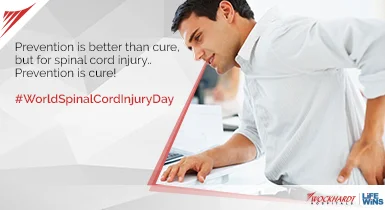World Spinal Cord Injury Day will take place on 5 September, aims to increase awareness throughout the community. Spinal cord injury is one of the most common causes of disability incapacitating an individual to lead a normal life.
This global day is an initiative of the International Spinal Cord Society (ISCoS) to build awareness and promoting the inclusion of disability throughout the world.
The spinal cord is a long, fragile tube-like structure that begins at the end of the brain stem and continues down almost to the bottom of the spine. It consists of nerves that carry incoming and outgoing messages between the brain and the rest of the body. The human spinal cord acts as our entire centre for reflexes. It is composed of 26 individual back bones called vertebrae. The vertebrae are separated by disks made of cartilage, which act as cushions, reducing the forces generated by movements such as walking and jumping.
Spinal Injury is caused due to direct injury to the cord itself or indirect damage from disease of the nearby bones, tissues, or blood vessels can lead to severe disability which includes severe consequences, like loss of voluntary movement and loss of sensations.
Other symptoms include:
- Loss of normal bowel and bladder control (may include constipation, incontinence, bladder spasms)
- Numbness
- Sensory changes
- Pain, weakness, and paralysis chronic pain and spasticity.
Although some patients quickly recover after injury, most patients with substantial cord damage have permanent symptoms.
According to World Health Organization (WHO) annually, around 250,000 to 500,000 people suffer a spinal cord injury (SCI) globally and the majority of the causes are preventable like road traffic crashes, falls or violence.
Some causes of Spinal injury include:
- Assault
- Falls
- Gunshot wounds
- Industrial accidents
- Motor vehicle accidents
- Sports injuries
Spinal fractures or dislocation of a vertebra:
Such fractures can cause bone fragments to pinch and damage the spinal nerves or spinal cord. Generally spinal fractures occur from car accidents, falls, gunshot, or sports. Injuries can range from mild ligament and muscle strains, to fractures and dislocations of the bony vertebrae, to debilitating spinal cord damage. Pain, difficulty walking, paralysis can occur. Many fractures heal with conservative treatment; however severe fractures may require surgery to realign the bones.
Spinal Cord Compression:
Spinal cord compression occurs when a mass places pressure on the cord. A mass can include a tumour or bone fragment. Compression can develop anywhere along the spinal cord from the neck to the lower spine. Some causes include certain degenerative diseases, such as arthritis, ruptured disk, Injury to the spinal cord or the area around the cord can lead to swelling can lead to compression.
Spinal Cord can indirectly also result in spinal injury disease due to:
- Tumours
- Infections such as meningitis and polio
- Inflammatory diseases
- Autoimmune diseases
- Degenerative disease
Type of spinal cord injury can be incomplete and complete.
- Incomplete spinal cord injuries: With incomplete injuries, the cord is only partially disconnected, allowing the injured person to retain some function.
Complete spinal cord injuries: By contrast, complete injuries occur when the spinal cord is fully severed, eliminating function.
Complications of spinal cord injury:
Damage can be either temporary or permanent. These changes translate into loss of muscle function, sensation, or autonomic function in parts of the body served by the spinal cord below the level of the lesion.
Treatment of Spinal Cord Injury includes:
- Immediate treatment is required for SCI since, time between injury and treatment has an impact on the treatment outcome.
- Medicines like corticosteroids often reduce swelling that can damage the spinal cord
- If spinal cord pressure is caused by a growth that can be removed or reduced before the spinal nerves are completely destroyed, paralysis may improve.
Spinal Cord Injury Surgery is needed in following cases:
- Realign the spinal bones (vertebrae)
- Remove fluid or tissue that presses on the spinal cord (decompression laminectomy)
- Remove bone fragments, disk fragments, or foreign objects
- Fuse broken spinal bones or place spinal braces
Physiotherapy Management and Rehabilitation of spinal cord injury includes the following:
- Stretching exercises to help maintain tendon and muscle length and/or to reduce muscle spasms.
- Flexibility exercises for entire body.
- Breathing exercises to help prevent chest infection and maximize lung function.
- Posture and balance exercises are to help reduce the pain that is associated with impaired balance and posture.
- Improve your functional activities and walking exercises
- Electronic muscle stimulators and exercise equipment are also used.
Goals of Rehabilitation include: This generally involves an interdisciplinary team to contribute to the rehab process of patient
- Physiotherapy focusing on lower limbs function and on helping with difficulties with mobility
- Occupational therapists address upper limb dysfunction and difficulties in activities of daily living
- bowel and bladder dysfunction and the management of pressure ulcers
- Dealing with emotional and behavioural concerns of the newly injured patient and with any potential cognitive dysfunction with help of physiatrist
- Speech-language for assisting in speaking and swallowing
- Support to family and educating them to take care of patient
- While each team member has primary responsibilities, any member of a properly functioning.
Spinal cord injury recovery occurs within the first six months after injury. Any remaining loss of function present after 12 months is much more likely to become permanent. Maintaining a positive outlook is extremely important for patients with spinal cord injury patients.
At Wockhardt Hospital:
Spine Surgery is a surgical speciality which is dedicated to the restoration and preservation of spine functions by managing various spinal disorders. It includes both non-operative and complex operative treatment modalities. At a glance, Spine Surgery in India, is a combination of orthopaedic and neurosurgical surgery. The speciality comprises a gamut of spinal surgeries with an aim to relieve pain, stabilization of spine and decompression of spinal cord/nerves.
At Wockhardt Hospital Spine Services Department is running A MULTI DISCIPLIANRY program in the country by a team of dedicated and highly experienced spine surgeons, neurophysicians neurosurgeons pain block experts, physiotherapists and rehabilitation experts. The speciality has one of the best of state of the art equipment, world class infrastructure, and diagnostic services in achieving the right diagnosis and bringing about optimal care.
The Spine surgery services department at Wockhardt Hospital is well complimented by an excellent physical therapy and rehabilitation department.
To understand more about the condition please contact our centres at Wockhardt Hospital.
Wockhardt Hospitals have been regarded as canters of excellence in field of neurosurgery including spine, with facilities in North Mumbai (Mira road), South Mumbai (Mumbai Central), Navi Mumbai (Vashi), Nagpur, Nasik, Rajkot and Surat. Wockhardt Hospitals is having state-of-the-art infrastructure whose prime objective is patient safety first and quality of care at the core of its strategy. The guiding philosophy is to serve and enrich the Quality of Life of patients and to make life win.




